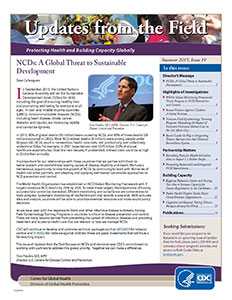Noncommunicable Diseases: About Us
What We Do: Reduce Chronic Disease and Injury
Deaths worldwide from noncommunicable diseases (NCDs) now exceed all communicable deaths combined and represent an emerging global health threat.1 Noncommunicable diseases include cardiovascular diseases, cancers, chronic respiratory diseases, diabetes, and other non-infectious conditions.
We work with partners worldwide to reduce diseases and injuries by identifying and addressing the risk factors that contribute to noncommunicable diseases (NCDs) and injuries. We do this by improving surveillance, generating new evidence, and strengthening the workforce.
Through trainings and exchanging knowledge and ideas, we make progress towards meeting the UN Sustainable Development Goals and the WHO Global Monitoring Framework to promote health and reduce premature deaths from NCDs.
Why It’s Important
Today, over 75% of all deaths in low- and middle-income countries are due to NCDs.1 While in high-income countries NCD-related deaths occur later in life, premature disability and death before age 70 is a leading health and development issue in low- and middle-income countries. High rates of NCDs and injuries place an additional burden on already fragile health systems, making countries less resilient when emergencies like infectious disease outbreaks or natural disasters strike.
Chronic disease and the lack of basic health care in developing countries affects U.S. national interests. Countries with healthier populations are more stable and prosperous; they are more viable trading partners; and they are better able to protect themselves.
How We Do It
The enormous social and economic toll of NCDs worldwide calls for an integrated approach. A key component of the global NCD strategy is spreading innovative solutions and making data-based decisions.
We use existing programs as platforms to extend our reach and resources. All of our programs foster partnerships to advance common goals and share technical expertise with countries.
CDC’s projects focus on changeable risk factors related to behavior and environment, such as use of tobacco products, excessive use of alcohol, an unhealthy diet, physical inactivity, and high blood pressure. Our activities addressing these risk factors and the associated diseases fall into three categories: improving surveillance, generating evidence, and strengthening the workforce. The table below describes the goals, activities, and programs that fall under each category.
| Category | Goal | Activities | Program(s) |
|---|---|---|---|
| Improving Surveillance | Strengthen surveillance and monitoring and evaluation systems |
|
|
| Strengthening Workforce | Strengthen infrastructure and workforce |
|
Field Epidemiology Training Program |
| Generating Evidence | Scale-up interventions to improve health outcomes | Generate scientific evidence by developing, implementing and scaling-up interventions to accelerate impact for priority risk factors or disease outcomes |
|
Improving surveillance, generating evidence, and strengthening the workforce are each integral to meeting our program goals. While all of our global NCD projects fall into these categories, most projects have elements that overlap, resulting in more comprehensive and impactful activities.
Fast Facts
- Over 40% of NCD deaths occur during the most productive life period, before age 70.1
- Over the next 15 years, $7 trillion is the projected economic loss attributed to NCDs in low- and middle-income countries.2
- Just $1 to $3 per person annually is required to control many NCDs.3
- Globally, more than nine people die every minute from injuries or violence—that’s 5.8 million people who die each year from both unintentional and violence-related injuries.4
- An estimated 4 million people die prematurely each year from illnesses associated with burning solid fuels for cooking, heating, and lighting.5
- The number of new cancer cases is expected to rise by about 70% over the next 2 decades. 6
Our Organization
We coordinate our activities with partner countries, international agencies, non-governmental organizations, other U.S. government agencies, and other CDC programs. Learn more about our partners….
For More Information
Council on Foreign Relations. The Emerging Global Health Crisis: Noncommunicable Diseases in Low- and Middle-Income Countries.
References
- WHO. Global status report on noncommunicable diseases, 2010. Page accessed 6/17/2016.
- World Economic Forum, Harvard School of Public Health. The global economic burden of non-communicable diseases. Page accessed 6/17/2016.
- WHO. Scaling up action against noncommunicable diseases: How much will it cost? Page accessed 6/17/2016.
- WHO. Injuries and violence: the facts. Page accessed 6/17/2016.
- WHO. Household air pollution and health. Page accessed 6/17/2016.
- WHO. Cancer. Page accessed 6/20/2016.
- Page last reviewed: April 28, 2017
- Page last updated: April 28, 2017
- Content source:


 ShareCompartir
ShareCompartir
